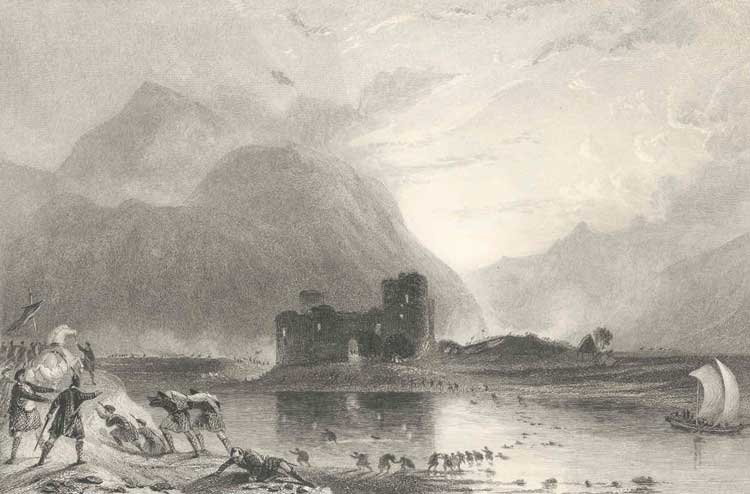History of the Stewarts | Battles and Historic Events
If you are a Stewart Society Member please login above to view all of the items in this section. If you want general information on how to research your ancestors and some helpful links - please look in background information.
If you have a specific question you can contact our archivist.

James I took an army north to deal with the rebellion. Meeting Alexander in Lochaber, possibly on the Badenoch border, James I defeated him in battle, helped to a large degree by the defection of the Camerons and Chattans to the Royal army. No longer having a viable candidate for the throne, Alexander´s position was drastically weakened. Alexander escaped, but James chased him across the Highlands and into the Hebrides. On 27 August 1429, Alexander surrendered to James at Holyrood and was imprisoned in Tantallon Castle.
Although Alexander was removed from the scene, James was not to gain any peace. Donald Balloch and Alasdair Carrach still wanted revenge for the murder of John Mór MacDonald (he was Donald´s father, and it is alleged that Carrach was his illegitimate son). They also wanted to obtain the release of their clan chief and so they continued the unrest in the north. James sent an army north in 1431 under the reliable Earl of Mar and the Earl of Caithness. They advanced to Lochaber to settle the insurrection, stopping at Inverlochy Castle, where Carrach had been garrisoned.
With Alexander out of the way, James I hoped to install Alexander Stewart, Earl of Mar as Lord of the Isles and thus break the power of the MacDonalds over the western seaboard. In early 1431 he was made Lord of Lochaber and a marriage was arranged between Alexander´s daughter and Lachlan Maclean forging a link with a significant faction within the Lordship of the Isles. Mar advanced into Lochaber to claim his new inheritance and by September 1431 was in Inverlochy where he had dislodged Alexander´s kinsmen, Alasdair Carrach, from the castle. In response Donald Balloch, younger cousin to the imprisoned Alexander, summoned members of his clan to a council of war on the Isle of Carna in Loch Sunart. From there the combined force sailed to Loch Linnhe.
The Royal army was led by the Earls of Mar and Caithness. Alexander Stewart, Earl of Mar, was the illegitimate son of the Wolf of Badenoch and was a similarly predatory noble who had taken his earldom by force in 1404; he had fought against Domhnall MacDonald, Lord of the Isles, in 1411 at the Battle of Harlaw, when the Stewart army had managed to hold the field against the onslaught of the MacDonalds. He survived James I´s purge of Albany´s relatives in 1424 and had been appointed Admiral of the Realm of Scotland. He remained the most important of the north-eastern lords until his death in 1435.
The Earl of Caithness was Allan Stewart, a grandson of Robert II by his second wife. His father was Walter Stewart, 1st Earl of Atholl, who had actively pursued the release of King James I from his detention in England. However, he subsequently conspired in the murder of James I in 1437 and, as a result, was tortured over three days in particularly gruesome fashion before his execution in Edinburgh.
Donald Balloch, the 18-year old son of John Mor and young cousin of Alexander of Islay, Lord of the Isles, who was now chief of the Macdonalds of Dunyveg and the Glens, fought alongside Alexander´s possibly illegitimate son, Alasdair Carrach of Tor Castle, in reaction to the arrest of Alexander. Following the victory at Inverlochy, Donald Balloch extracted revenge on Clans Cameron and Chattan for siding with the King by ravaging their lands before fleeing to Ireland. He was declared an outlaw and James I was determined to see him punished despite his exile. A head purporting to be Donald´s was sent to James I by Hugh Boy, Chief of the O´ Neills of Ulster; the King´s honour was restored and he no longer pursued Donald. However, it transpired that the head did not belong to Donald, who was later involved in several further actions against the Stewarts before his death in 1476.
Alasdair Carrach appears to have been known by Alexander´s previously bestowed title of Lord of Lochaber, but some Lochaber lands and Keppoch lands, including Glen Roy and Glen Spean in Brae Lochaber, were granted to Malcolm Mackintosh of Clan Chattan by the King, who had stripped the lands from Lochaber and gifted them to Mackintosh as a reward for his loyalty during the Battle of Inverlochy. Mackintosh managed to retain the lands even after the death of the King, when Alexander confirmed the land grant on 21 February 1443; he also granted Malcolm the Castle of Dingwall in November 1447, which led to tensions between the Clan Chattan and the MacDonalds for centuries to come.
The precise location of the battlefield is unknown but it is likely Mar´s force was camped on the ground immediately to the north-east of Inverlochy Castle. The MacDonalds sailed along Loch Linnhe and launched a three pronged attack. Alasdair Carrach commanded a detachment of archers who occupied the high ground overlooking the royal camp. At the same time, Balloch charged from the south routing Mar´s men whilst the remnant of Carrach´s soldiers attacked from the other direction. The battle soon descended into a series of skirmishes but the Royal supporters had lost the initiative and were slaughtered. Some accounts suggest up to 1,000 Royal soldiers were killed in the defeat including Alan Stewart, Earl of Caithness. The Earl of Mar escaped the scene.
The defeat ended James I´s attempts to break the Lordship of the Isles . Whilst the King attempted to raise revenue for a new expedition, insufficient funds were generated and ultimately he was forced to reconcile with Alexander. The imprisoned lord was released and subsequently would become the foremost magnate in northern Scotland

